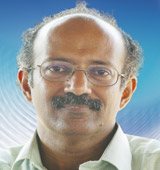dialogue with the
fishermen of neighbouring
Kanyakumari District who also had
around 10 societies working on the
same model. The Kanyakumari
societies promised to join the
federation once it was up and
running.
This made the outlook of the
proposed federation very different.
From a district level federation, its
profile changed to that of an interstate
organization just because
Trivandrum and Kanyakumari lay on
either side of the Kerala-Tamil Nadu
border. Eugene Culas, the activist
who took the lead to organize the new
federation, then went one step ahead
and ambitiously named the
organization SIFFS and included
Karnataka and Andhra Pradesh in the
area of operation for good measure.
When I joined SIFFS in 1982, it was
still an organization of the
Trivandrum fishermen. The
Kanyakumari fishermen would join
only three years down the line. Yet
the name "SIFFS" influenced my
thinking and I imagined SIFFS
spreading all over South India and
living up to its name. However, a
number of factors made this
expansion a slow and erratic process.
Even today SIFFS is only the
federation of fishermen societies in 11
out of the 22 coastal districts of Kerala
and Tamil Nadu. We do have some
societies in the Union Territory of
Pondicherry and a couple of
experimental societies in Andhra
Pradesh. Thus, we are still struggling
to live up to our name. It is therefore
unreasonable to expect SIFFS to go
beyond South India at present.
A major handicap for expansion has
been the history that different NGOs
organized the primary societies in
different districts and SIFFS only
inherited these groups. The science
and art of organizing societies were
not properly systematized like the
Anand Pattern Societies. SIFFS itself
lacked human resources to do this
work. It is only in the mid-1990s that
we tried to develop our own expertise
in this and started working in North
Kerala. This gave us valuable
experience of organizing societies in a
new area requiring modifications to
our village society model.
In 2000, we then entered the northcentral
coast of Tamil Nadu and
started organizing societies. This time
we have been a lot more successful.
From the humble annual growth rate
of three societies we are now doing
almost 10 new societies a year. This
gives hope that SIFFS will live up to
its name in a few years time.
This realization that SIFFS has many
institutional limitations for promoting
societies across the coast was one of
the factors that triggered my plan to
resign as SIFFS CEO and start a new
National NGO to promote fisheries
development across the Indian coast.
The new organization is being
registered at the moment, but has
already started working in Gujarat
organizing fishermen societies in the
remote district of Kutch.
-
I understand that you have
travelled widely across the globe
representing the fisheries sector of
India. How do you compare the
traditional fisheries sector in India
with that of other developed and
developing countries?
There are both commonalities and
dissimilarities. At one level, all
marine capture fisheries in the world
are going through a crisis stagnation
and even decline of catches due to
over-fishing and a failure to manage
the fisheries. However, how the
problem is being looked at in
developed countries and developing
countries is somewhat different.
To start with, it is important to
understand that marine capture
fisheries are based on a Common
Pool Resource (CPR) that is finite and
exhaustible. Open access is the
enemy of such CPRs as this leads to
depletion of the resource. The
challenge, therefore, is how to restrict
access, especially after the initial
phase of development (based on
under exploited resources) is over. It
is in this that there is big difference
between the ways the developed
countries and developing countries
look at fisheries management.
Most developed countries, if you look
at the map carefully, are found in the
temperate zone where the fish species
diversity is limited and each species is found in large abundance. This has
led to large scale fishing units that
focus on catching particular fish
species. In addition, most developed
economies have gone through a social
transformation that has led to very few
persons willing to continue in the
primary production sectors like
agriculture and fisheries. There is
actually a labor shortage for fishing in
many of the developed countries. The
Norwegians, famous for their fishery
in the Arctic Circle, are actually
employing Sri Lankan Tamils (who
went in large numbers as political
refugees) as labor on their boats!
Yet another difference that influences
the way developed countries look at
fisheries is the general level of social
security prevalent in those countries
with the State providing doles or
unemployment insurance. One may
lose a job but one is not necessarily
on the roads because of that. Each
sector of the economy is managed
purely from point of view of
efficiency and competitiveness rather
than for preservation of jobs in that
particular sector. Even the big
agriculture subsidies that we hear of
in Europe and the US are actually
meant to protect the interest of agribusiness
than labor.
